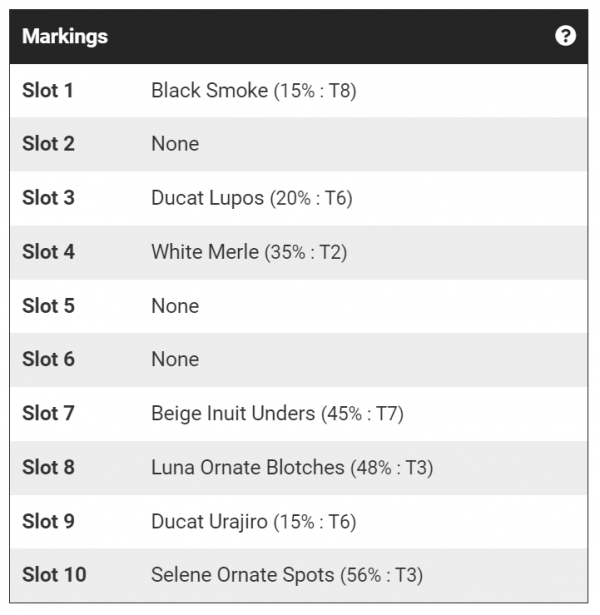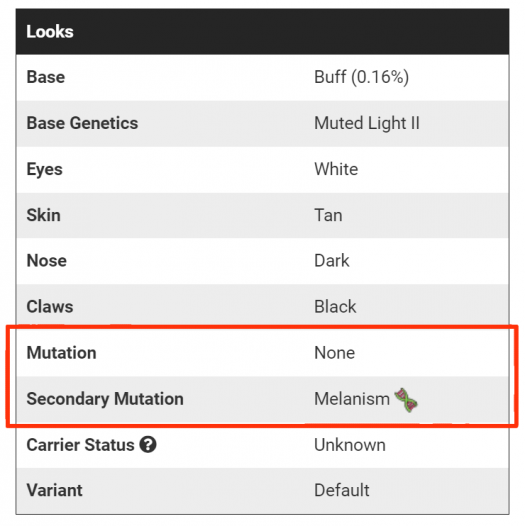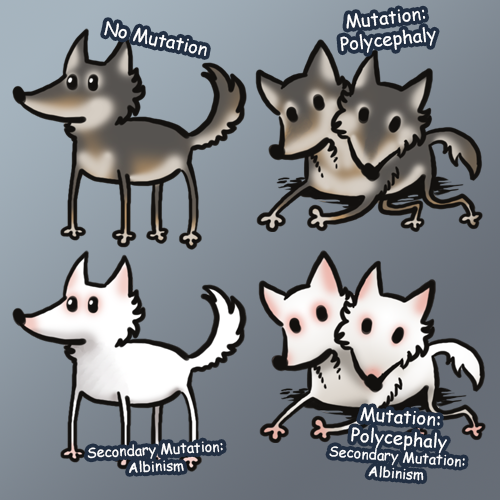Genetics and Appearance
From Grouse House Wiki
| Excuse the mess... | |
| The wiki grouse are still chipping away at this page... we'll announce once it's complete, so check back soon! | |
This guide goes into detail on how every aspect of Wolvden's genetics system works, including bases, eyes, and everything else!
Base Genetics
Base Genetics
Each base has its own genetics that determine how it passes through breeding. Bases are given three categorizations based on its appearance and rarity. You can view the genetics of a wolf's base on their page, under the Looks section.
"Muted Dark II" is the base genetics of the base displayed above, Pecan. These are the three categories that the base was assigned, and they can be read in the order of Color, Shade, Rarity. The percentage in parentheses next to the wolf's base name is the percentage of wolves in the game that also have that base. So, in this screenshot, 0.36% of all wolves in the game have the Pecan base.
There are four main color groups which most bases will be assigned -- Cool, Muted, Warm, and Monochrome. The categorization is based on the general appearance of the base. There are also Special color bases, which are categorized as such due to their extra rarity rather than their actual color. (More details about Special bases are available later in this guide.) Breeding similar colors together will help make breeding outcomes more predictable. For example, breeding a Cool base with another Cool base will guarantee that all pups from the breeding will also have Cool bases.
In addition to colors, bases come in three different shades -- Light, Medium, and Dark. This is based on how "bright" the base appears.
The final categorization, rarity, is either I, II, or III. This value shows how difficult the base is to obtain. A rarity of I means that it is very common, while a rarity of III means that it is very rare. Special bases do not have rarities in genetics, so their rarity is instead represented by *. Tier I bases are the easiest to breed, and Tier III bases are the most difficult to breed.
Base Pass Rates
Base Pass Rates
When considering the pass rates of bases, it's important to note that base genetics is not a matter of "this base x this base = that base". Rather, the bases that are produced from a breeding are determined by the genetics of the base (the color group, shade, and rarity) instead of the base itself.
When crossed, some color groups are less compatible with each other, and end up producing less predictable outcomes. If you would like to have a guaranteed chance to get a certain color group or shade, make sure to pair wolves together that will produce only those categories.
Below are outlines of the possible outcomes of certain category combinations. The separate categories do not affect each other and are all calculated separately. For example, a parent having a Warm base will not affect the base shade of the offspring. These tables do not include specific probabilities of getting each outcome, because specifics have not been revealed by developers.
| Color | |
| Cool + Cool | Cool |
| Cool + Muted | Cool, Muted, Monochrome |
| Cool + Warm | Cool, Muted, Warm, Monochrome |
| Cool + Monochrome | Cool, Monochrome |
| Muted + Muted | Cool, Muted, Warm, Monochrome |
| Muted + Warm | Muted, Warm, Monochrome |
| Muted + Monochrome | Muted, Monochrome |
| Warm + Warm | Warm |
| Warm + Monochrome | Muted, Warm, Monochrome |
| Monochrome + Monochrome | Monochrome |
| Shade | |
| Light + Light | Light |
| Light + Medium | Light, Medium |
| Light + Dark | Light, Medium, Dark |
| Medium + Medium | Light, Medium, Dark |
| Medium + Dark | Medium, Dark |
| Dark + Dark | Dark |
| Rarity | |
| I + I | I |
| I + II | I, II |
| I + III | I, II, III |
| II + II | I, II |
| II + III | I, II, III |
| III + III | I, II, III |
Special Circumstances
Special Circumstances
Breeding Bases with Matching Categories
On top of the chances presented with normal genetics, breeding bases with matching categories -- being the same color group, shade, and rarity -- result in those specific bases having an additional 25% chance of passing directly to the pup. If the bases bred have the same color group and shade, but not the same rarity, the additional chance drops based on how far the rarities are apart. If the rarities are one step apart, the additional chance will be 5%, while if the rarities are two steps apart, the chance will be dropped to 0.5%.
For example, if you breed a Warm Medium I base to a Warm Medium III base, there will be an additional 0.5% chance on top of normal pass rates that the pup produced will have the same base as one of their parents. If you breed a Warm Medium II base to a Warm Medium III base, there will be an additional 5% chance for either base to pass directly to the pup. Finally, if you breed two Warm Medium IIIs together, there is an additional 25% chance for the pup to get either of the parents' bases.
This information was originally detailed in a Wolvden Tumblr post about genetics.
Special Bases
Unlike other bases, Special bases can only be obtained through breeding if one of the parents has the same specific Special base. A wolf with a Special base cannot produce any Special base other than its own. Do note that Special bases do not have a rarity, and are not a tier, hence their tier being represented by a *. When this guide refers to "any tier", Special bases are excluded from this. Special bases are completely separate from each other and do not share any overall tier category.
Breeding two different Special bases together has the chance to fail to any color group and rarity, though the shades of the Special bases are taken into consideration when determining which bases can be produced.
A Special base bred to a base of a different color group has the chance to either produce that Special base, or any base within the color group of the other parent. For example, a Special x Cool pairing will fail to Cool bases only.
Below are some other examples of Special base breedings that are possible.
- Special Light (Selene) x Special Light (Selene) = Any Light base (any tier or color), or Selene
- Special Light (Selene) x Special Dark (Losna) = Any base (any tier, shade, or color), or Selene or Losna
- Special Light (Selene) x Warm Light III = Any Warm Light base or Selene
- Special Medium (Luna) x any Tier I or Tier II base = Any Tier base from the non-special base's colour group, or Luna
You cannot breed any normal bases together to get a Special base. For example, you cannot breed two Tier III bases together to get a Special base. In order to breed a specific Special base, one of the parents must have that specific base.
The only Special bases currently available are obtainable using applicators purchased or obtained during events.
Eye Genetics
Eye Genetics
Eye genetics are much simpler than base genetics.
In a breeding, eyes can either pass directly from the genetic parents, or produce one of several "fail" colors. There seems to be an even 50/50 chance for a puppy to get either a fail color or an inherited color. If it is determined that the pup will get one of the parent's eye colors, there seems to be a 50/50 chance in determining which parent's eye color it will be. These are estimated rates based off of scried data.
For example, when breeding Ice eyes and Indigo eyes together, there is a 50% chance that the pup will get either Ice or Indigo eyes, and a 50% chance that the pup will get a fail color of Ice or Indigo.
There is a small chance that a breeding of either Black x White or Blue x Brown eyes will produce a pup with Heterochromia eyes in those colors. No other combinations of colors could produce these eyes. For example, Glass x Brown does not have the ability to produce Hetero Blue & Green. However, some eye colors can fail into Hetero colors, even if the parent does not have Hetero eyes or either of the colors required.
The table in the following section lists every eye color, their possible fails, and how they can be obtained. Note that not all of the fail colors listed here are confirmed, and some may be missing.
Eye Catalogue
Eye Catalogue
The following section lists every single eye color in the game, methods to obtain each, and their fail colors.
| Yellow | |||
| NBWs, Customisation | |||
| Can fail to: Brown and Orange |
Marking Genetics
Marking Genetics
This page includes an overview of marking genetics. For more detailed information on each marking, tier, obtention, and marking mechanic, take a look at the Markings page.
Marking Categories and Rarities
Marking Categories and Rarities
Markings are sorted similarly to bases in that they have a color and rarity. An additional category is added to reflect marking shapes.
The color of the marking is very straightforward and is representative of the hue of the marking. The color of the marking will be important if you're interested in breeding combo markings.
There are currently [TBD] different marking colors to choose from.
Wolves have a dedicated section on their pages for Markings. Here, you can see the color, shape, and tier of each marking they have. Wolves can have up to ten markings.

The first number in parentheses next to each marking is the marking's opacity. The opacity represents the vibrancy or transparency of the marking—how much it stands out or blends into other markings.
The second number in parentheses is the marking's "tier". Every marking is sorted into a category based on the way it is obtained. These tiers are not representative of how rare a marking is; they just define where the marking comes from. Certain categories of markings define what a marking is able to do. For example, Tier 0 and Tier 1 markings are able to mutate into similar shapes, but no other tier of marking can.
Marking Tiers
T0 - Basic NBW Markings
T1 - Custom
T2 - Raffle/Rare
T3 - Applicator
T4 - [ Empty Category ]
T5 - Placeholder/"Unreleased" (Markings are placed in this category if they are not meant to be RMA-able, like raffle stud markings before the raffle is pulled, and lunar event markings until after their debut event is over)
T6 - Combo Markings & Some Deviations
T7 - RMA
T8 - Rare NBW
Every marking, regardless of these tiers, has a chance to drop from a Random Marking Applicator!
Marking Pass Rates
Marking Pass Rates
Markings
If both parents have a marking in a specific slot, there is an estimated 60% chance that the pup will get any marking in that slot at all. If it is decided that the pup will get a marking in the slot, there is a 50/50 chance for which parent's marking it will receive. Identical markings that are bred in the same slot (i.e., both parents have the exact same marking in the same slot) have a 75% chance of passing directly to the pup, rather than a 60% chance.
If only one parent has a marking in a specific slot, the puppies have a 50% chance to obtain that marking.
(Special thanks to Nika (#10475) and Mossfoot (#23226) for these calculations!)
Opacities
The opacities of the parents' markings will affect what opacity the pup's marking will have. The opacity does not affect the pass rate of the actual marking. The pup's marking will be the average of the two parent's opacities in that slot, give or take about 10%. This could be represented by the formula below:
(mother's opacity + father's opacity)/2 ± 10%
If one parent does not have a marking in that slot, their opacity is 0%. So, if only one parent has a marking in that slot and the pup inherits that marking, the opacity will be 1/2 of the one parent's opacity, also with 10% wiggle room.
Since this April 2022 news post, marking opacities that are calculated to be 0% or below are corrected to 1%, so there is no chance of a marking "disappearing" from opacity calculations.
(Special thanks to Coal (#476) for the formula and tips!)
Marking Deviations
Some marking shapes may produce deviations, or mutations, from breeding.
There is a small chance that certain marking shapes will mutate into different shapes within the same tier, but only if the original marking is a Tier 0 or Tier 1 marking. Markings are likely to only mutate into markings with similar names. For example, the Cape marking may mutate into the Cape Ticking marking.
Markings not in Tier 0 or Tier 1 will not mutate (so, for example, the Wings Heavy marking (T2) could not mutate into the Wings marking).
Combo Markings
Combo markings are another marking mechanic that is rolled during genetics calculations.
Some marking color combinations will produce combo colors. To produce a combo marking, the wolves that are bred must have compatible colors in the same marking slots. The marking shapes do not have to be the same as each other, but one of the shapes must also have a version in the combo color. So, if one parent has a White Cross marking and the other parent has a Black Dilution marking in the same slot, the pup would have a chance to get Silver Cross or Silver Dilution.
Combo markings will pass in a normal breeding just like any normal marking. For example, if wolf has Silver Cape, a combo marking, the puppies can inherit Silver Cape directly without the need for Black or White markings.
The following table lists every combo color and the combinations used to get them.
| Possible Combo Colors and Combinations to Get Them | |
|---|---|
| Auburn | Black + Red |
| Deira | Beige + Honey |
| Dinar | Honey + Brown |
| Doubloon | Honey + Yellow |
| Ducat | Yellow + White |
| Sepia | Brown + Yellow |
| Silver | Black + White |
| Sterling | Silver + Black |
| Tuff | Silver + Cream |
| Zircon | Red + Cream |
Nose, Skin, and Claw Genetics
Nose, Skin, and Claw Genetics
Mutations
Mutations
Mutations are a rare part of a wolf's genetics that make them unique! Not all wolves have mutations, but those that do can be more valuable or more visually distinct than other wolves.
On each wolf, there are two slots available for mutations. This means that two mutations can be bred onto the same wolf. However, not all mutations can be doubled up. Some mutations, like Brachycephaly, are always primary, so they always taken up the main mutation slot and cannot be paired with other primary mutations. Some mutations, like Albinism or Melanism, will always take up the secondary mutations slot. This means that a wolf might have no primary mutations, but can have a secondary mutation present.
In general, large, drastic mutations with lineart changes will take up the primary mutation slot while smaller changes like albinism will take up the secondary mutation slot.

Wolves with mutations will also have icons next to the mutation name on their wolf page. These icons reflect what kind of mutation the wolf has. More information about these different kinds of mutations is available on the Mutations page.

Art of the concept of secondary mutations from Wolvden's Tumblr.
